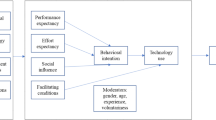Abstract
The design of support systems for cognitive work needs to account for the different patterns of activity resulting from changes in context. The contextual control modes from Hollnagel’s model of control are presented as a suitable framework to describe these patterns and to identify the implications for design of support systems. The design and evaluation of a prototype support system for airline operations is used as a case study in supporting multiple cognitive control modes. The evaluation of the prototype with experts illustrated clear and distinguishable changes in the patterns of activity in different contextual control modes. Notably, different designs were demonstrated to support particular contextual control modes and to disrupt cognitive activity in contextual control modes which they were not intended to support.












Similar content being viewed by others
Notes
The amount of time allowable to resolve the problem, which may be assessed relative to the time required to resolve the problem.
References
Beyer H, Holtzblatt K (1998) Contextual design. Academic Press, San Diego
Billings C, Woods DD (1994) Human performance in automated systems: Current research and trends. Chapter concerns about adaptive automation in aviation systems, Lawrence Erlbaum and Associates, pp 24–29
Brehmer B (1992) Dynamic decision making: human control of complex systems. Acta Psychol 81(3):211–241
Clarke M, Smith B (2004) Impact of operations research on the evolution of the airline industry. J Aircraft 41(1):62–72
Clarke J-P, Malconian T, Rabbani F (2007) MEANS–the MIT extensible air network simulation. Simulation 83(4):385–399
Feigh KM (2006), Contextual inquiry of a 100 aircraft regional airline systems operation center. Technical Report GTCEC2006-0001, Georgia Tech Cognitive Engineering Center
Feigh KM (2007a), Contextual inquiry of a 50 aircraft regional airline systems operation center. Technical Report GTCEC2007-0002, Georgia Tech Cognitive Engineering Center
Feigh KM (2007b), Contextual inquiry of a major us airline systems operation center. Technical Report GTCEC2007-0001, Georgia Tech Cognitive Engineering Center
Feigh KM (2008) Design of cognitive work support systems for airline operations. PhD thesis, Georgia Institute of Technology
Feigh KM, Pritchett AR (2005) Airline operations managers: an introduction to the third leg of the national air transportation system. In 6th USA/Europe ATM R&D seminar. Baltimore, Maryland
Feigh KM, Pritchett AR (2010) Modeling work for cognitive work support system design in operational control centers. J Cogn Eng Decis Mak 4(1):1–26
Feigh KM, Pritchett AR, Jacko JA, Denq T (2005) Decision making during an airline rescheduling task: a contextual control model description. In 13th international symposium on aviation psychology. ISAP, Oklahoma City
Feigh KM, Pritchett AR, Jacko JA, Denq T (2007) Contextual control modes during an airline rescheduling task. J Cogn Eng Decis Mak 1(2):169–185
Frisch D, Clemen RT (1994) Beyond expected utility: rethinking behavioral decision research. Psychol Bull 116(1):46–54
Hammond KR (2000) Judgments under stress. Chapter: the cognitive continuum theory of judgment. Oxford University Press, New York
Hilburn B, Flynn G (2004) Human performance, situation awareness and automation: current research and trends (HPSAAII), vol 1 and 2. Chapter toward a non-linear approach to modeling air traffic complexity. Lawrence Erlbaum, pp 207–213
Hoffman RR, Militello LG (2008) Perspectives on cognitive task analysis. Taylor & Francis, New York
Hollnagel E (1993) Human reliability analysis: context and control. Academic Press, London
Hollnagel E (1998) Co-operative process management. Chapter: context, cognition and control. Taylor & Francis Ltd., London
Jobidon ME, Rousseau R, Breton R (2004) Time in the control of a dynamic environment. Proceedings of the human factors and ergonomics society 48th annual meeting. HFES, New Orleans, pp 557–561
Johnson KE, Kuchar JK, Oman CM (2002) Experimental study of automation to support time-critical replanning decisions. Proceedings of the human factors and ergonomics society 46th annual meeting. HFES, Baltimore, p 5
Keeney RL, Raiffa H (1993) Decisions with multiple objectives. Cambridge University Press, Cambridge
Kerstholt JH (1996) The effect of information costs on strategy selection in dynamic tasks. Acta Psychol 94:273–290
Kirlik A (1993) Modeling strategic behavior in human-automation interaction: why an “aid” can (and should) go unused. Hum Factors 35(2):221–242
Klein G (1997) Decision making under stress. Chapter: the current status of the naturalistic decision making framework. Ashgate Publishing Ltd., Aldershot
Klein G (1998) Sources of power: how people make decisions. MIT Press, MIT
Klein GA (2005) The strengths and limitations of teams for detecting problems. Cogn Tech Work 8:227–236
Maule JA (1997) Decision making under stress. Chapter strategies for adapting to time pressure. Ashgate Publishing Ltd., Aldershot
Niwa Y, Hollnagel E (2001) Enhancing operator control by adaptive alarm presentation. Int J Cogn Ergon 5(3):367–384
Orasanu J, Connolly T (1993) Decision making in action: models and methods. Chapter: the reinvention of decision making. Ablex, Norwood
Orasanu J, Salas E (1993) Decision making in action: models and methods. Chapter team decision making in complex environments. Ablex, Norwood, NJ
Payne JW, Bettman JR, Johnson EJ (1993) The adaptive decision maker. Chapter contingencies in decision making. Cambridge University Press, New York
Pujet N, Feron E (2000) Modeling an airline operations control center. Air Traffic Control Q 7(4):127–141
Rasmussen J (1983) The role of hierarchical knowledge representation in decision making and system management. IEEE Trans Syst Man Cybern SMC-15(2):234–243
Stanton NA, Ashleigh MJ, Roberts AD, Xu F (2001) Testing Hollnagel’s contextual control model: assessing team behavior in a human supervisory control task. Int J Cogn Ergon 5(2):111–123
Todd PA, Benbasat I (1992) The use of information in decision making: an experimental investigation of the impact of computer based decision aids. MIS Q 16(3):373–393
Todd PA, Benbasat I (1994) The influence of decision aids on choice strategies under conditions of high cognitive load. IEEE Trans Syst Man Cybern 24(4):537–547
van Westrenen F (2010) Cognitive work analysis and the design of user interfaces. Cogn Technol Work 12(4):1–12
Woods D, Branlat M (2010) Hollnagel’s test: being ‘in control’ of highly interdependent multi-layered networked systems. Cogn Tech Work 12:95–101
Author information
Authors and Affiliations
Corresponding author
Rights and permissions
About this article
Cite this article
Feigh, K.M. Incorporating multiple patterns of activity into the design of cognitive work support systems. Cogn Tech Work 13, 259–279 (2011). https://doi.org/10.1007/s10111-010-0165-0
Received:
Accepted:
Published:
Issue Date:
DOI: https://doi.org/10.1007/s10111-010-0165-0




